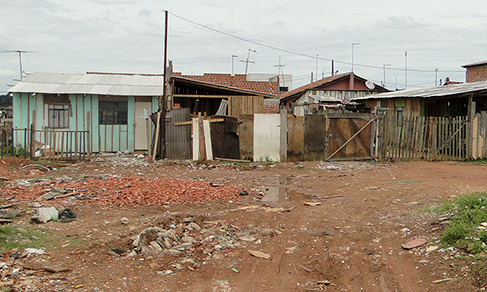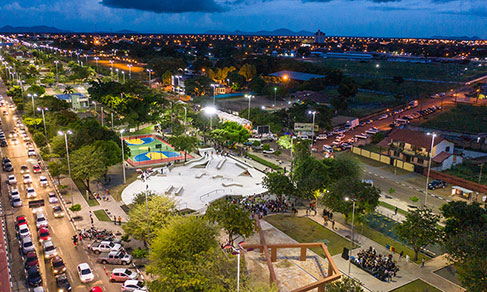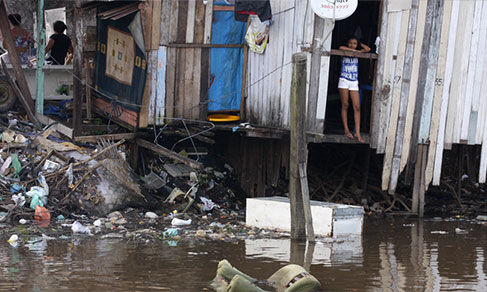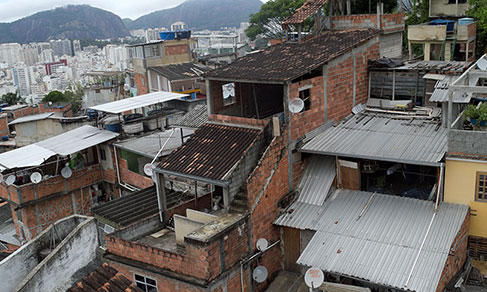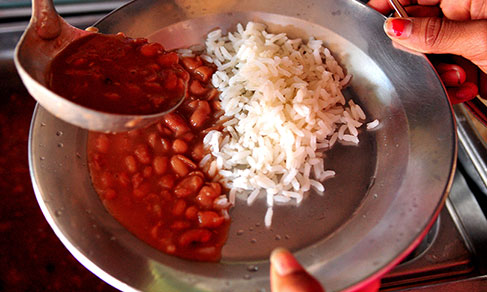Nossos serviços estão apresentando instabilidade no momento. Algumas informações podem não estar disponíveis.
POF - Consumer Expenditure Survey
About - Analysis of Personal Food Consumption in Brazil
The 2008-2009 Consumer Expenditure Survey had the purpose of providing information about the composition of household expenditure based on the investigation of consumption habits, expenditure allocation and income distribution, considering the characteristics of households and people. POF also investigated self-perceived life quality and the nutritional profile of the Brazilian population.
In this publication, IBGE presents an analysis of the food consumption of the Brazilian population aged 10 or over. The data registered in the Sheet of Personal Food Consumption were used in the elaboration of the publication. Each resident took notes of all the food consumed inside and outside of the housing unit for two non-consecutive days, in the urban and rural areas of the whole country, throughout twenty-four hours of the day. The employed methodology was based on several data sources, such as the Table of Reference Measures for Food Consumed in Brazil, Tables of the Nutritional Composition of Food Consumed in Brazil, both resulting from 2008-2009 POF, and technical-scientific publications.
The estimates of the averages of consumption of food, energy and nutrients are presented for the total population, considering sex, groups of age, geographic region, housing unit location and classes of income. The publication also presents the prevalence of consumption inadequacy relative to macro and micronutrients, calculated based on national and international parameters, such as EAR (estimated average requirement) proposed by the Institute of Medicine – IOM –, for the population of the United States and Canada. The study was conducted in partnership with the Ministry of Health. For the evaluation, compilation and structuring of the results, IBGE counted on the contribution of technicians and specialists in nutrition, with notable experience and competence, from the Ministry.
Main results - Analysis of Personal Food Consumption in Brazil
#tabelasidra20176510013523
#tabelasidra201765143221593
Tables - Analysis of Personal Food Consumption in Brazil
- -Food intake #pof2008analisedoconsumoalimentarpessoalnobrasil
- -Energy and Nutrient Consumption #pof2008analisedoconsumoalimentarpessoalnobrasil
Food intake
- Table 1.1 - Average food intake per cpita and percentage of consumption away from home in relation to total intake, by sex, by food items - Brazil - 2008-2009
- Table 1.2 - Prevalence of food intake, by sex, according to food items - Brazil - 2008-2009
- Table 1.3 - Prevalence of food intake, average food intake per capita and percentage of food away from home in relation to total intake, by urban or rural area, according to food items - 2008-2009
- Table 1.4 - Prevalence of food intake and average food intake per capita, by Major Region, considering food items - Brazil - 2008-2009
- Table 1.5 - Percentage of food away from home in relation to the total consumed, by Major Region, considering food items - Brazil - 2008-2009
- Table 1.6 - Prevalence of food intake, average food intake per capita and consumptionaway from home in relation to the total consumption of teenagers, adults and the elderly, considering food items - Brazil - 2008-2009
- Table 1.7 -Prevalence of food intake and average food intake per capita, by class of total income and family asset change per capita, considering food items - Brazil - 2008-2009
- Table 1.8 - Percentage of food away from home in relation to the total intake, by class of total income and family asset change per capita, considering food items - Brazil - 2008-2009
- Table 1.9 - Percentiles 10, 50 and 90 of groups of selected food, by sex - Brazil - 2008-2009
Energy and Nutrient Consumption
- Table 2.1 - Average of energy and nutrient consumption and percentage of the total calorie consumption of nutrients, by sex and groups of age, considering nutrients - Brazil - 2008-2009 period
- Table 2.2 - Average of energy and nutrient consumption and percentage of the total calorie consumption of nutrients, by sex, groups of age and housing unit location, considering nutrients - Brazil - 2008-2009 period
- Table 2.3 - Average of nutrient consumption and percentage of total calorie consumption of nutrients, by sex and groups of age, considering Major Region - 2008-2009 period
- Table 2.4 - Average of consumption of minerals and vitamins, by sex and groups of age, considering nutrients - Brazil - 2008-2009 period
- Table 2.5 - Average of consumption of minerals and vitamins, by sex, groups of age and housing unit location, considering nutrients - Brazil - 2008-2009 period
- Table 2.6 - Average of consumption of minerals and vitamins, by sex and groups of age, considering Major Region - 2008-2009 period
- Table 2.7 - Prevalence of inadequacy and percentiles 10, 50 and 90, with nutritional recommendations for micronutrient consumption for teenagers aged 10 to 13 and 14 to 18, by sex - Brazil - 2008-2009 period
- Table 2.8 - Prevalence of inadequacy and percentiles 10, 50 and 90, with nutritional recommendations for micronutrient consumption for adults aged 19 to 59 and 60 or over, by sex - Brazil - 2008-2009 period
- Table 2.9 - Prevalence of inadequacy and percentiles 10, 50 and 90, with nutritional recommendations for micronutrient consumption for teenagers aged 10 to 13 and 14 to 18 in urban area, by sex - Brazil - 2008-2009 period
- Table 2.10 - Prevalence of inadequacy and percentiles 10, 50 and 90, with nutritional recommendations for micronutrient consumption for teenagers aged 10 to 13 and 14 to 18 in rural area, by sex - Brazil - 2008-2009 period
- Table 2.11 - Prevalence of inadequacy and percentiles 10, 50 and 90, with nutritional recommendations for micronutrient consumption for adults aged 19 to 59 and 60 or over in urban area, by sex - Brazil - 2008-2009 period
- Table 2.12 - Prevalence of inadequacy and percentiles 10, 50 and 90, with nutritional recommendations for micronutrient consumption for adults aged 19 to 59 and 60 or over in rural area, by sex - Brazil - 2008-2009 period
- Table 2.13 - Prevalence of inadequacy and percentiles 10, 50 and 90, with nutritional recommendations for micronutrient consumption for teenagers aged 10 to 13 and 14 to 18, by sex - North Region - 2008-2009 period
- Table 2.14 - Prevalence of inadequacy and percentiles 10, 50 and 90, with nutritional recommendations for micronutrient consumption for teenagers aged 10 to 13 and 14 to 18, by sex - Northeast Region - 2008-2009 period
- Table 2.15 - Prevalence of inadequacy and percentiles 10, 50 and 90, with nutritional recommendations for micronutrient consumption for teenagers aged 10 to 13 and 14 to 18, by sex - Southeast Region - 2008-2009 period
- Table 2.16 - Prevalence of inadequacy and percentiles 10, 50 and 90, with nutritional recommendations for micronutrient consumption for teenagers aged 10 to 13 and 14 to 18, by sex - South Region - 2008-2009 period
- Table 2.17 - Prevalence of inadequacy and percentiles 10, 50 and 90, with nutritional recommendations for micronutrient consumption for teenagers aged 10 to 13 and 14 to 18, by sex - Central-West Region - 2008-2009 period
- Table 2.18 - Prevalence of inadequacy and percentiles 10, 50 and 90, with nutritional recommendations for micronutrient consumption for adults aged 19 to 59 and 60 or over, by sex - North Region - 2008-2009 period
- Table 2.19 - Prevalence of inadequacy and percentiles 10, 50 and 90, with nutritional recommendations for micronutrient consumption for adults aged 19 to 59 and 60 or over, by sex - Northeast Region - 2008-2009 period
- Table 2.20 - Prevalence of inadequacy and percentiles 10, 50 and 90, with nutritional recommendations for micronutrient consumption for adults aged 19 to 59 and 60 or over, by sex - Southeast Region - 2008-2009 period
- Table 2.21 - Prevalence of inadequacy and percentiles 10, 50 and 90, with nutritional recommendations for micronutrient consumption for adults aged 19 to 59 and 60 or over, by sex - South Region - 2008-2009 period
- Table 2.22 - Prevalence of inadequacy and percentiles 10, 50 and 90, with nutritional recommendations for micronutrient consumption for adults aged 19 to 59 and 60 or over, by sex - Central-West Region - 2008-2009 period
Concepts and methods - Analysis of Personal Food Consumption in Brazil
As informações a seguir descrevem os metadados estatísticos, que são o conjunto de conceitos, métodos e aspectos relacionados às estatísticas, e são informações necessárias para compreender as características e a qualidade das estatísticas e interpretá-las corretamente.
Informações Gerais
Objetivo
As informações da pesquisa são utilizadas para atualizar as estruturas de ponderações, necessárias para a produção dos Índices de Preços ao Consumidor (Índices, calculados e publicados mensalmente pelo IBGE, que indicam a variação média ocorrida nos preços do conjunto de bens consumidos e de serviços utilizados pela população) e também na atualização da participação das despesas das famílias no cálculo das Contas Nacionais. Além disso, permitem estudar a evolução dos hábitos de consumo das famílias e possibilitam os mais variados estudos e planejamentos sobre: distribuição, concentração e desigualdade de renda, aspectos demográficos e socioeconômicos, quantidade adquirida "per capita". A partir da POF 2002-2003, além de cobrir todo o País (áreas urbana e rural), foram incluídas as aquisições de produtos realizadas pelas famílias através de aquisições não monetárias (doações, trocas, retiradas do negócio, produção própria). Também foram incluídos novos temas relacionados à nutrição, investigando as medidas antropométricas - peso e altura -, a quantidade de alimentos adquiridos no domicílio e pesquisando também aspectos sobre as condições de vida das famílias - Questionário de avaliação subjetiva das condições de vida. Na POF 2008-2009, todos os objetivos e temas descritos anteriormente foram mantidos como também a abrangência geográfica. Também, nesta pesquisa atendendo novas demandas, foram incluídas variáveis relacionadas aos temas Meio Ambiente, Turismo, Assistência à Saúde, Fecundidade e também maiores detalhamentos em relação a antropometria. Nesta versão da pesquisa, foi incluída uma primeira experiência na utilização de um modelo metodológico para investigação do consumo efetivo pessoal, definido e trabalhado em parceria com o Ministério da Saúde. Este modulo foi pesquisado através do Bloco de consumo alimentar pessoal - POF7.Tipo de operação estatística
Pesquisa de orçamento familiarTipo de dados
Dados de pesquisa por amostragem probabilísticaPeriodicidade de divulgação
QuinquenalPopulação-alvo
Domicílios particulares permanentes ocupados e seus moradores, na área de abrangência da pesquisa nas situações urbana e rural. Foram excuídas as áreas definidas pelo IBGE como sendo quartéis, bases militares, alojamentos, acampamentos, embarcações, penitenciárias, colônias penais, presídios, cadeias, asilos, orfanatos, conventos e hospitais.Metodologia
A seleção da amostra adotada nas pesquisas utilizou um plano amostral conglomerado em dois estágios de seleção, com estratificação geográfica e estatística das unidades de primeiro estágio. Os setores correspondem às unidades do primeiro estágio de seleção e os domicílios particulares permanentes, às unidades do segundo estágio.
Para garantir a distribuição de todos os estratos geográficos e socioeconômicos durante os doze meses, a POF foi dividida em 52 períodos de sete dias. Para cada domicílio selecionado, foram indicados aleatoriamente, dentre esses períodos, dois consecutivos em que obrigatoriamente foi iniciada a coleta.
As informações da POF foram obtidas diretamente nos domicílios particulares permanentes selecionados, por meio de entrevistas realizadas pelas Equipes Regionais do IBGE, junto aos seus moradores, durante um período de nove dias consecutivos, através da aplicação de equipamentos eletrônicos sob a forma de entrevistas e de registros diários pelo informante.
Os procedimentos metodológicos adotados para o tratamento das informações coletadas na POF são: validação na entrada de dados, tratamento do efeito inflacionário sobre as informações de valores (deflacionamento ou inflacionamento), análise do valor das despesas e rendimentos, alocação das despesas informadas na forma agregada, tratamento da não resposta de valores de despesas e rendimentos, anualização dos valores de despesas e rendimentos e o tratamento das informações de quantidades adquiridas de alimentos.
O Bloco de consumo alimentar pessoal (POF7) foi investigado em uma subamostra de domicílios selecionados, durante dois dias não consecutivos, para os moradores com 10 anos ou mais de idade, para o registro de todos os alimentos e bebidas consumidos dentro e fora do domicílio.
Técnica de coleta:
PAPI - Entrevista pessoal com questionário em papel, CAPI - Entrevista pessoal assistida por computadorTemas
Temas e subtemas
Família, Grupos populacionais específicos, Rendimento, despesa e consumo, Estatísticas multidomínio, População, Condições de vida, pobreza e desigualdade, Habitação, Saúde, Proteção socialPrincipais variáveis
Domicilio: tipo do domicílio; cômodos - total, servindo de dormitórios e total de banheiros; condição de ocupação; abastecimento de água; esgotamento sanitário; origem da energia elétrica; material que predomina no piso; pavimentação na rua do domicílio; tempo de moradia; e características do aluguel.Famílias: tamanho da família; e bens duráveis (inventário), condições de vida.
Pessoas: relação com a pessoa de referência da família; condição de presença; idade; sexo; nível de escolaridade; cor ou raça; religião; peso e altura; atividade/ocupação.
Orçamentos: despesa global; despesa corrente; despesa de consumo; aumento do ativo; diminuição do passivo; local de compra; despesa mensal familiar; rendimento total; rendimento do trabalho; transferências; rendimento de aluguel; outros recebimentos; rendimento mensal domiciliar; rendimento mensal familiar; rendimento mensal pessoal e movimentação financeira.
Na POF 2008-2009, foram incluídas as seguintes variáveis relacionadas ao tema meio ambiente: localização do domicílio, separação do lixo, coleta seletiva do lixo, destino do lixo, origem da energia elétrica, fonte própria de energia elétrica, aquecimento de água, combustível utilizado no fogão.
Também foram incluídas variáveis relacionadas ao tema nutrição como: amamentação materna, alimentação escolar. E ainda foram incluídas variáveis do tema fecundidade.
Unidades de informação
Unidade de investigação
Família, Pessoa, Domicílio, ProdutoUnidade de análise
Família, Pessoa, Domicílio, Produto.Períodos de referência
Data de início da coleta
19/05/2008Data do fim da coleta
18/05/2009Disseminação
Formas de disseminação
Publicação Digital (online), Publicação impressa com CD-ROM, CD-ROM com microdados, Banco Multidimensional de Estatísticas - BMENível de divulgação
Para áreas urbanas, os resultados foram produzidos nos níveis Nacional, Grandes Regiões, Unidades da Federação, nove Regiões Metropolitanas (Belém, Fortaleza, Recife, Salvador, Belo Horizonte, Rio de Janeiro, São Paulo, Curitiba e Porto Alegre) e todas as capitais das Unidades da Federação. Para áreas rurais, os resultados foram produzidos nos níveis Nacional e Grandes Regiões.Instrumentos de coleta
POF 1 - Características do domicílio e dos moradores
POF 2 - Questionário de aquisição coletiva
POF 3 - Caderneta de aquisição coletiva
POF 3 - Folha suplementar
POF 4 - Questionário de aquisição individual
POF 5 - Questionário de trabalho e rendimento individual
POF 6 - Avaliação das condições de vida
POF 7 - Bloco de consumo alimentar pessoal .
Histórico
A segunda pesquisa realizada no período de 1995-1996, teve a mesma abrangência da anterior e visou a atender aos mesmos objetivos.
A terceira Pesquisa de Orçamentos Familiares 2002-2003 deu igual prioridade às utilizações descritas anteriormente, além de atender a novas demandas, principalmente aquelas relacionadas a aspectos de nutrição e condições de vida. A partir desta edição a abrangência geográfica foi ampliada para todo território Nacional, cobrindo todas as áreas urbana e rural do país.
Em 2008-2009 o IBGE realizou a quarta pesquisa, que além de manter o objetivo principal - Orçamentos Familiares -, que permite obter as estruturas de consumo das famílias e também o valor total da conta família, também incluiu os temas nutrição e condições de vida, tendo um maior aprofundamento no tema nutrição. O modelo metodológico da pesquisa também atendeu diversas novas demandas, sendo incluídas diversas variáveis relacionadas a Meio Ambiente, Turismo, Assistência à Saúde e Fecundidade.
Nesta pesquisa, também foi incluída uma primeira experiência metodológica de investigação do consumo efetivo pessoal. Através de um novo questionário - Bloco de consumo pessoal individual (POF7), o consumo efetivo de alimentos e bebidas no domicílio e fora do domicílio foi investigado para uma subamostra de domicílios, .
Saiba mais
https://metadados.ibge.gov.br/consulta/estatisticos/operacoes-estatisticas/OFPublications - Analysis of Personal Food Consumption in Brazil
Description
The Consumer Expenditure Survey - POF assesses the structures of consumption, expenditures, income and part of the asset variation of the households, providing a profile of the life conditions of the population based on the analysis of the household budgets. In addition to the information directly associated with the budget structure, a number of characteristics of the housing units and households are also investigated, including the subjective self-assessment of life quality. The results of the survey also allow to study the composition of the household expenditures according to the income classes, regional disparities, urban and rural status, diffusion and volume of transfers between different income classes, as well as the dimension of the consumer market for groups of products and services. The survey has the household as the investigation unit and it is based on sampling.
The 2008-2009 POF was the fifth survey carried out by the IBGE on household budget. The previous editions were: the 1974-1975 National Study of Household Expenditure - ENDEF, with a nationwide coverage, except for the rural areas of the North and Central-West Regions; the 1987-1988 POF; the 1995-1996 POF; and the 2002-2003 POF. The Consumer Expenditure Surveys of the 1980s and 1990s were conceived to primarily update the consumer structures of the consumer price indexes produced by the IBGE, being accomplished in the Metropolitan Areas of Belém, Fortaleza, Recife, Salvador, Belo Horizonte, Rio de Janeiro, São Paulo, Curitiba and Porto Alegre, in the Municipality of Goiânia, and in the Federal District. Besides covering the entire Brazilian territory, the POFs of the 2000s included additional subjects over the previous editions, due to the need of detailed information on the life conditions based on the consumption, particularly of the households with lower income, the reason why the rural area was included in the geographic coverage and the non-monetary purchases were also investigated.
The current sample design of POF was structured in such a way that it releases the results at the following levels: Brazil, Major Regions and also by urban or rural status. The results include the totals and the urban situation for the Federation Units. The results correspond to the urban situation in the nine Metropolitan Areas and Municipalities of the Capitals. As of the project called Master Sample, developed by the IBGE to implement the Integrated System of Household Surveys - SIPD, the Consumer Expenditure Surveys had the sample design defined by the Master Sample, and its sectors selected among those from that sample.
Microdata
2017-2018
Updated on 3/4/2021
- Data
- Documentation - updated on 04/23/2021
- Questionnaires - updated on 04/23/2021
- Table Translators
- Reading Software
- Calculation Memory
- Readme
2008-2009
- Data - updated on 10/05/2021
- Documentation - updated on 10/05/2021
- Questionnaries
- Table Translators
- Manual of the Survey Agent
- Readme
2002-2003
Technical Information
Methodological considerations on the Consumer Expenditure Survey can be obtained in the Technical notes chapter of its results publication.
News and Releases
POF 2017-2018
Three new indexes show drop of poverty and vulnerability between 2008-2009 and 2017-2018
For the first time ever, the IBGE releases, as experimental statistics, the Evolution of Non-Monetary...
25/08/2023
POF 2017-2018
POF: Socioeconomic performance index for Brazil grows 12.8% between 2008 and 2018
The IBGE released today (23) an updating of the indicators that measure the quality of life of the Brazilian...
23/06/2023
POF 2017-2018
2017-2018 POF: Loss of quality of life is almost twice as much in rural areas
The IBGE presents for the first time a multidimensional index for the loss of quality of life (IPQV),...
26/11/2021
POF 2017-2018
Loss of quality of life is almost twice as much in rural areas
The loss of quality of life of people living in the rural areas of the country is almost twice as big...
26/11/2021
POF 2017-2018
POF 2017-2018: 72.4% of Brazilians lived in households that had trouble paying for monthly expenses
Approximately 72.4% of Brazilians lived in housing units having trouble paying for monthly expenses,...
19/08/2021
POF 2017-2018
Households headed by white persons spend almost twice on travel and leisure than those headed by blacks or browns
Households headed by white persons spent almost twice on travel and leisure, between 2017 and 2018, than...
19/08/2021
POF 2017-2018
72.4% of Brazilians live in households that have trouble paying their bills
Approximately 72.4% of the Brazilian population lived were members of households that had trouble paying...
19/08/2021
POF 2017-2018
30% of the population with the lowest earnings live on less than the necessary amount to make ends meet
About 30% of the persons with the lowest earnings in the country, between 2017 and 2018, lived on less...
25/11/2020
POF 2017-2018
2017-2018 POF: proportion of food secure households stands below 2004 level
In 2017-2018, of the 68.9 million households in Brazil, 36.7% (equivalent to 25.3 million) had some degree...
17/09/2020
POF 2017-2018
10.3 million persons live in households with severe food insecurity
Severe food insecurity was present in the home of 10.3 million Brazilians at least for some time between...
17/09/2020
Errata
Amendment of the average intake of fibers for women aged 60 years and over, in table 15 of POF 2017-2018 – Analysis of personal food intake in Brazil
Published date: 15/01/2021
Description:
Identification of an error in the generation of Table 15, only for the cell on the average intake of fibers for women aged 60 years and over.Actions: The result was reviewed and updated in the publication table.
Calendar error in the release of the Consumer Expenditure Survey - POF 2017-2018 - Household Food Acquisition per Capita
Published date: 12/07/2019
Description:
An error, identified by the IBGE, for the non-compliance with the release data established in December 2018. Due to rescheduling, the new release date for the results of the Consumer Expenditure Survey - POF 2017-2018 - Household Food Acquisition per Capita for the 1st semester of 2020.
Actions: The release calendar was corrected.
Descrição:
Erro, identificado pelo IBGE, pelo não cumprimento da data de divulgação da pesquisa, conforme calendário disponibilizado em dezembro de 2018. Em virtude da necessidade de readequação de prazos, a data de divulgação dos resultados da Pesquisa de Orçamentos Familiares POF 2017-2018 -Aquisição Alimentar Domiciliar per Capita foi reagendada para o primeiro semestre de 2020.
Ações: O calendário de divulgação foi alterado.Calendar error in the release of the Consumer Expenditure Survey (POF) 2017-2018 - First Results
Published date: 10/06/2019
Description:
An error, detected by the IBGE, relative to non-compliance to the release date informed in the calendar made available in December 2018. Due to the need of rescheduling, the new release date of the Consumer Expenditure Survey (POF) 2017-2018 - First results is October 04, 2019.
Actions: The release calendar was changed.
Calendar Error in the Consumer Expenditure Survey 2017-2018 - Household Food Acquisition per Capita
Published date: 10/06/2019
Description:
An error, detected by the IBGE, relative to non-compliance to the release date informed in the calendar made available in December 2018. Due to the need of rescheduling, the new release date of results of the Consumer Expenditure Survey 2017-2018 - Household Food Acquisition per Capita is December 18, 2019.Actions: The release calendar was changed.
Nutritional composition of food
Tables of Nutritional Composition of Food Intake in Brazil
To see comparative graphs and information tables, select at least one item in the "Food" menu and one in the "Preparation Method(s)" menu and click on "Insert food".




